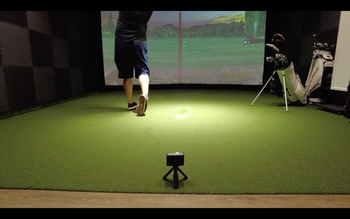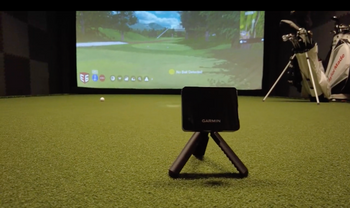So Foresight Sports just dropped their QuadMAX at the PGA Show back in January, and let me tell you - this thing makes the old GCQuad look like a flip phone.
You know how tour pros are picky about their gear, right? Well, Marc's been tracking this trend where more and more of these guys are ditching their old launch monitors for the GCQuad during warmups. Watch any tournament coverage and you'll spot 'em everywhere on the range.
Here's the thing, though - the QuadMAX takes everything those pros loved and cranks it up a notch. We're talking faster processing, cleaner data, and features that'll actually help you figure out why you're slicing that driver.
Now, I know what you're thinking - "How's this stack up against Trackman?" Fair question. Both are top-shelf gear that'll drain your wallet faster than a Vegas weekend. But where Trackman uses radar to track your ball flight, the QuadMAX uses four high-speed cameras that capture everything at impact. That means you're getting spin rates, launch angles, and club data that's scary accurate - even indoors where radar can get wonky.
The real game-changer? This bad boy shows you exactly what your club face is doing at impact. You'll finally know if you're hitting it toe-side or if that open face is causing your banana ball. It's like having a tour-level coach who never gets tired of watching your swing.
Sure, you could buy a decent used car for what this costs. And honestly, if you're just trying to break 100, save your money and get lessons instead. But if you're serious about dialing in your distances and fixing that two-way miss, the QuadMAX gives you the data to actually do something about it.
Table of Contents
Foresight QuadMAX vs GCQuad: Side-by-Side Specs Breakdown
Alright, so you're looking to dial in your game with a launch monitor? Let me break down what makes the QuadMAX different from the GCQuad - I've spent hours with both of these bad boys.
First off, they'll both track everything you need to know about your shots. Your launch angle, how fast that ball's spinning, where it's gonna land, and whether you're slicing it into the next county. They measure the same stuff - ball speed, carry distance, spin axis, even that descent angle that tells you if your shots will actually hold the green.
Both units give you the full scoop on your swing, too. You'll see your clubhead speed (spoiler: it's probably slower than you think), your attack angle, and that dreaded face angle that shows why you keep missing right. They'll even show you where on the face you're making contact - super helpful when you're convinced you're hitting it pure, but the numbers say otherwise.
Here's where things get interesting though. The QuadMAX comes with this touchscreen that makes navigating through data way easier than fumbling with buttons. You can customize what shows up on screen with their MyTiles feature - pretty sweet when you just want to see carry distance and spin rate without all the other noise.
Got a need for speed? The QuadMAX has a speed training mode built right in. Perfect for those winter months when you're trying to add 10 yards before spring. The GCQuad? You're out of luck there.
Battery life is clutch too. The QuadMAX runs for 7-9 hours on its 12,000mAh battery, while the GCQuad taps out after 6-8 hours with its smaller battery. Both have swappable batteries though, so you can keep a spare charged if you're doing all-day practice sessions.
Weight-wise, the QuadMAX is actually lighter at 6.3 pounds compared to the GCQuad's 7.5 pounds. Doesn't sound like much, but when you're lugging it around the range, you'll notice.
The QuadMAX also has some tech-savvy features like QR codes and NFC that make sharing data with your instructor or buddies super easy. Just tap phones and boom - your swing data's transferred.
Both units nail the basics with their four-camera setup (that's what "quadrascopic" means - basically four angles capturing your swing and ball flight). The hitting zone is identical at 18" by 14", giving you plenty of room to spray it around while you're working on that new swing thought.
One small but nice touch - the QuadMAX automatically turns on its backlight when you need it. The GCQuad? You're flipping that switch manually every time the light changes.
Look, either one will transform how you practice. You'll finally know your real distances (hint: you don't hit your 7-iron 175), understand why certain shots curve, and have actual data to improve instead of just guessing. The QuadMAX edges ahead with its user-friendly features, lighter weight, and longer battery life - plus that speed training mode is money for adding distance.
Is it worth the investment? If you're serious about dropping strokes and you practice regularly, absolutely. Just seeing your impact location will probably save you three shots a round once you fix that heel strike pattern. But if you only hit balls twice a month, maybe stick with your best guesses and spend the money on lessons first.
Bottom line - the QuadMAX gives you tour-level data in a package that's actually enjoyable to use. Your practice sessions become purposeful instead of just beating balls, and that's when real improvement happens.
Foresight QuadMax Launch Monitor
Experience the pinnacle of golf technology with the Foresight QuadMax, a premium launch monitor that redefines precision and performance.
Why Foresight Sports Launch Monitors Are Gaining Popularity
You know how the pros always seem to have their numbers dialed in perfectly? Well, here's the deal - they're all switching to these launch monitors called GCQuad and QuadMAX. And once you hear why, you'll get why your local club fitter probably has one too.
First off, Foresight Sports basically owns the accuracy game when it comes to tracking what your ball and club are doing. We're talking tour-level precision that actually tells you the truth about your swing, even when you don't want to hear it.
Here's what kills me about trying to use other systems like Trackman at the range. You spend half your practice time just getting the thing positioned right. With these Foresight units? You're hitting balls and getting feedback in under a minute. That's more time working on your game instead of fiddling with equipment.
The new QuadMAX takes it up a notch with basically endless memory for storing your shots. Think about that - you could track every swing from now until next season without running out of space. Pretty wild for us data nerds who love seeing our progress over time.
But here's my favorite part, and why you'll love this at the range. All your numbers show up right there on the unit's screen. No phone apps, no laptops, no BS. You hit a shot, look down, and boom - there's your carry distance, spin rate, and launch angle staring back at you. Try getting that instant feedback from a Trackman without jumping through hoops.
Look, I'm not saying everyone needs to drop serious cash on tour-level tech. But if you're tired of guessing whether that new driver is actually helping or just feels good, this gives you the real story. Plus, nothing builds confidence like knowing exactly how far you carry each club. No more coming up short on that water carry because you thought your 7-iron went 165 when it really goes 155.
Comparing Costs: GCQuad, QuadMAX, and TrackMan

So you're looking at dropping serious cash on a launch monitor? Let's talk real numbers here. You're not sweating over price tags at this level - we're way past the "should I or shouldn't I" phase.
Here's where it gets interesting though. Trackman wants you to fork over $21,495 just to get started. Then they hit you with another grand every year for software. Meanwhile, Foresight's throwing their GCQuad out there for $14,500 if you just want ball data, or you can go all-in at $19,999 with everything included.
Their new QuadMAX? That'll run you $19,999 right off the bat with both ball and club data. Want to track your putting, too? Add another $2,500. But here's the kicker - PlayBetter's got this sweet deal where they'll hook you up with the whole simulator setup (we're talking enclosure, impact screen, mat, projector - the works) starting at just under 24 KK.
Now compare that to Trackman's full simulator package. Are you ready for this? They want up to $49,000. That's like buying a nice car instead of improving your golf game.
Here's what kills me - both systems give you basically the same data and accuracy. They're tracking your shots with the same precision, measuring the same spin rates, launch angles, and ball speeds. The technology's different (Trackman uses radar, Foresight uses cameras), but the results? Pretty much identical to what you need.
You'd think with that massive price difference, Trackman would blow Foresight out of the water. But when you dig into what each system actually does for your game, the gap in performance doesn't match the price gap, not even close.
Foresight GCQuad Golf Launch Monitor & Simulator
The undisputed king of golf launch monitors, the GCQuad delivers unmatched precision with exclusive Quadrascopic imaging technology for ultimate performance.
GCQuad, QuadMAX, and TrackMan: Features at a Glance
You're looking at some serious tech differences between these launch monitors that'll affect both your practice sessions and your wallet. Let me break it down for you.
First off, if you're setting up in your garage or basement, you'll want the GCQuad or QuadMAX - they sit right next to the ball and use high-speed cameras to track everything. The Trackman? That beast needs to sit way behind you, using radar waves like a cop catching speeders. You'd need a massive space to make it work indoors, which most of us don't have.
Weight-wise, you're carrying around similar pounds whether you grab the Trackman or the QuadMAX - neither one's breaking your back. The GCQuad's actually the lightest of the bunch, which is sweet if you're hauling it between the range and your buddy's simulator setup.
Here's where it gets interesting with the tech. Those Foresight units (that's the company making GCQuad and QuadMAX) use photometric technology - basically super fancy cameras that capture thousands of images per second to see exactly what your ball and club are doing at impact. The Trackman bounces radar signals off your ball to track its flight. Both work great, but they're totally different animals under the hood.
You know what'll drive you nuts about the Trackman? Every time you switch from your backyard to indoor practice, you've gotta recalibrate the thing. The Foresight monitors? Set 'em up once and you're golden for months. Plus, the Trackman doesn't even have its own screen - you're stuck connecting your phone or tablet every single time. The QuadMAX changed the game here with its built-in display and insane storage capacity. You could literally save every shot you hit for the next decade and still have room left over.
Money talks, and the GCQuad and QuadMAX won't murder your bank account quite as badly as the Trackman. You're still dropping serious cash - we're talking good-used-car money here - but you'll save enough to maybe grab that new driver you've been eyeing.
For most weekend warriors trying to break 80 (or, honestly, just break 90 consistently), the camera-based units make more sense. You get tour-level accuracy, easier setup, and they work perfectly in that spare bedroom you converted to a golf cave. The Trackman's amazing tech, don't get me wrong, but unless you've got a warehouse-sized space or mainly practice outdoors, you're paying extra for features you can't fully use.
TrackMan Golf Launch Monitor
TrackMan 4 is the elite launch monitor, trusted by pros for its dual radar tech, unmatched accuracy, and advanced golf simulation.
How Foresight Sports Stacks Up Against TrackMan Technology
So you're looking at dropping serious cash on a launch monitor, right? Let me break down how these two big players actually work, because they're totally different animals.
You've got Foresight Sports with their GCQuad and QuadMAX - these bad boys use four super-fast cameras that snap thousands of pictures per second. Think of it like having four sports photographers capturing your swing and ball flight from different angles. Those cameras catch everything about how your club meets the ball and what happens next.
Now Trackman? Completely different beast. This unit shoots radar waves at your ball - same tech cops use to nail speeders. The radar follows your ball's entire journey through the air, tracking every wobble and curve from impact to landing. It's basically stalking your golf ball with invisible waves.
Here's what matters for your game: Both systems nail the important stuff like how fast your ball leaves the clubface, how much it's spinning, and where it's gonna land. The Foresight cameras are money when you want to know exactly what your club's doing at impact - perfect for those days when you're trying to figure out why you're hitting it fat.
The radar setup in Trackman shines when you want the full picture of your ball flight. It'll tell you everything about that banana slice you just hit, including how much it curved and why. Pretty helpful when you're trying to straighten out that driver.
Both systems deliver tour-level accuracy on the numbers that matter. Whether you choose cameras or radar, you're getting data that'll show you exactly why you're leaving approach shots short or spraying drives into the next fairway. The real difference is which type of feedback helps your brain make better swings.
Data Showdown: The Quads Versus TrackMan
So you're looking at launch monitors and trying to figure out what'll actually help your game? Let me break down these bad boys for you.
The Foresight GCQuad gives you everything you'd need to diagnose your swing. You get your launch angle (how high the ball takes off), your ball speed, total spin, and where you're hitting it on the face. It'll tell you if you're swinging over the top with that club path number, and whether you're hitting down on it too steeply with the angle of attack. Even shows you if your club face is open or closed at impact - that's your face angle. Pretty wild stuff.
The QuadMAX takes it up a notch. You'll see how high your ball peaks in flight, the angle it's coming down at, and exactly how far offline you're missing. Think of it as getting the full story of your shot from start to finish.
Now, Trackman's got similar data, but here's where they're different. The Foresight units are money when you're hitting into a net in your garage. They use high-speed cameras looking at impact, so they nail those club delivery numbers every time. You'll know exactly why you're slicing - maybe that face is 5 degrees open, or your path is cutting across the ball.
Trackman's your outdoor warrior, though. It uses radar to follow your ball's entire flight, so when you're at the range, it's tracking that thing all the way to landing. Nothing beats seeing your actual ball flight numbers when you're working on that draw.
Here's what this means for your game. With either Foresight model, you'll finally understand why you hit those weak fades. Maybe your smash factor's low (that's how efficiently you're transferring energy to the ball), or your spin axis is tilted way right. Once you know the problem, you can actually fix it instead of guessing.
The limitation? Foresight's better for indoor use, while Trackman needs space to track the full flight. And yeah, we're talking serious cash here - think new-set-of-irons money. But if you're practicing regularly and want to drop from that 20 handicap to single digits, knowing your exact numbers beats hitting bucket after bucket, hoping something clicks.
Bottom line - if you've got a home setup or use an indoor facility, go Foresight. If you're mainly an outdoor range rat who wants to see actual ball flight, Trackman's your play. Either way, you're getting tour-level feedback that'll fast-track your improvement.
Are These Launch Monitors Ideal for Home Golf Simulators?

So you're thinking about setting up your own golf simulator and trying to decide between the big dogs - GCQuad, QuadMAX, and Trackman. Let me break down what you're actually getting when you drop the cash.
Picture this: You've got a GCQuad or the brand-new QuadMAX sitting in your man cave. Right out of the box, you're loaded with software that'll make your jaw drop. We're talking FSX Play and the full FSX 2020 package, plus 25 courses that look so real you'll swear you can smell the fresh-cut fairway. The FSX Pro Performance software? That's where the magic happens for fixing your swing.
Here's the kicker - Foresight throws in an Awesome Golf lifetime membership too. No yearly fees are eating into your beer money. And if you're the type who loves options, these bad boys play nice with pretty much every SIM software out there. GSPro, E6 Connect, Creative Golf - take your pick. They've even got you covered with a 2-year warranty and all the cables and markers you need.
Now, Trackman's a different animal. Sure, it's got some slick features like shot analysis and this Tracy AI coach that'll talk you through your swing flaws. They've even got something called "normalization" - basically, it figures out how your shots would fly at sea level on a calm day, even if you're practicing in Denver during a windstorm. Pretty neat stuff.
But here's where it gets sticky. Trackman really shines when you're hitting balls outside. Indoors? It works, but it's like driving a Ferrari in rush hour traffic - you're not getting what you paid for. Plus, and this is the part that'll make you choke on your beer, they want a grand every year just for the software subscription. That's right - $1,000 annually on top of what you already paid.
Look, both systems will tell you everything about your swing-ball speed, launch angle, spin rate, the works. But when you're already investing simulator money, do you really want to keep paying every year just to use what you bought? With GCQuad or QuadMAX, you're getting premium indoor performance and software that's yours forever. No subscriptions, no surprises, just pure golf improvement whenever you want it.
My take? Unless you're planning to haul your launch monitor to the range every week, go with Foresight. Your wallet and your handicap will thank you.
Final Thoughts: Choosing Between Foresight Sports and TrackMan
You're looking at dropping serious cash on a top-shelf launch monitor? Let me tell you why Foresight Sports might be the smarter play than going with Trackman, especially if you're building an indoor setup.
Here's what's wild - the GCQuad and QuadMAX actually give you better club data than what most tour pros get from other systems. We're talking face angle, strike location, and spin axis numbers that'll show you exactly why that shot curved left into the water. Those four high-speed cameras capture everything at impact, which matters when you're trying to fix that nasty slice.
Look, Trackman owned this space forever. Every other launch monitor got measured against it, kind of like how everyone compared putters to Scotty Cameron for years. These days, though? The game's changed. You've got multiple companies building tech that matches or beats what used to cost you a small car.
Foresight's been quietly dominating for a while now. They're not some startup trying to break in - they've engineered different models at different price points, all using the same camera-based tech that makes their readings so accurate. Whether you grab their entry-level unit or go full QuadMAX, you're getting tour-level data.
PlayBetter's pumped about this because it means regular golfers like us can access the same feedback that helps pros dial in their games. And honestly? That's a game-changer for anyone serious about dropping their handicap.








